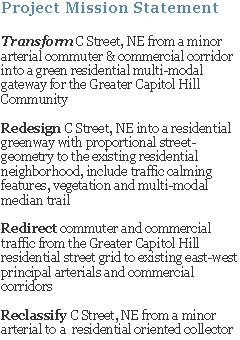***************************************************************************

C Street NE redesign down to three options
April 16, 2010
By: Molly Nevola, Voice Correspondent
Residents are evaluating three options for a community-led project to reconstruct C Street NE as a safer and more environmentally friendly thoroughfare.
The designs will be presented at a public meeting April 19. The project’s managers said they hope to begin construction in 2012.
An initiative five years in the making, the project began when residents started speaking out about dangerous conditions on C Street NE from the East Capitol Street Bridge to roughly 14th Street.
“Primarily, this is a quality-of-life project,” said Northeast Capitol Hill advisory neighborhood commissioner (ANC 6A) Bill Schultheiss, who also works for Toole Design Group, the firm engineering the construction.
The corridor is unique: Two lanes come off of the East Capitol Bridge and immediately feed into a five-lane section on C Street that becomes seven lanes with parking.
Police data has shown that cars typically come off the highway onto C Street at 55 mph, well above the 40 mph limit on the bridge and 25 mph limit on C Street. The speeding contributes not only to dangerous conditions for pedestrians and bikers, but also noise problems, Schultheiss said.
According to the Metropolitan Police Department’s Sgt. Mark Robinson, there were 13,246 westbound vehicular speeding citations in the area — an average of 23 per day — between December 2007 and June 2009. Police are currently monitoring the eastbound side.
The purpose of the street’s redesign, Schultheiss said, is to make drivers aware that they’re entering a school zone and a residential neighborhood.
All of the design options would shrink the width of the currently 90-foot-wide street, cutting it nearly in half in hopes of creating a safer bicycling environment and more space for greenery in the medians.
The project also aims to make other green improvements — building surfaces like sidewalks out of permeable materials; creating areas to catch stormwater; and planting sustainable, low-maintenance greenery.
“We saw that we’d be able to introduce innovative and interesting green elements that I’d seen on the West Coast. The city was excited about that,” Schultheiss said.
Schultheiss jumped on board as the project’s manager along with community activist Ken Granata, a 36-year-old engineer and D.C. native who has lived at C Street and 17th Place for six years.
“The scope of the project became much more than we ever anticipated, which is nice,” Granata said.
After witnessing traffic issues and hearing residents’ complaints, Granata decided five years ago to engage the D.C. Department of Transportation and community groups. He began blogging about traffic on C Street in June 2006, creating “CSTNE Project” in 2008.
The site outlines the project from beginning to end, and displays all proposed alternative designs, as well as information on the resident-run workshops that led to the options.
“The goal from the beginning was to have residents in the neighborhood and greater Capitol Hill community reconsider what C Street is for,” Granata said.
Residents involved in the workshops have since narrowed down the options for the street to three possible designs. One plan will be chosen by consensus and presented to the Transportation Department, which will get the final say.
The first design option eliminates bike lanes and removes one eastbound lane; the second uses parking lanes as morning rush hour driving lanes and narrows the street by 10 more feet. A third option would permanently eliminate a travel lane, allowing full-time parking there.
Granata said the project was planned without a budget in mind.
“From the beginning, DDOT, Toole Design Group, and the community all said, ‘Let’s not put any constraints on money. Let’s go big, let’s go bold and push it in every way possible — the ultimate — and go from there,’” Granata said.
But Schultheiss said the city’s 2012 capital improvements budget allocates money for the construction. An official from the Transportation Department said the project is budgeted for $6 million, but that figure is “more of a placeholder.”
The above article was extracted, in its entirety, from the Voice of the Hill website.


No comments:
Post a Comment